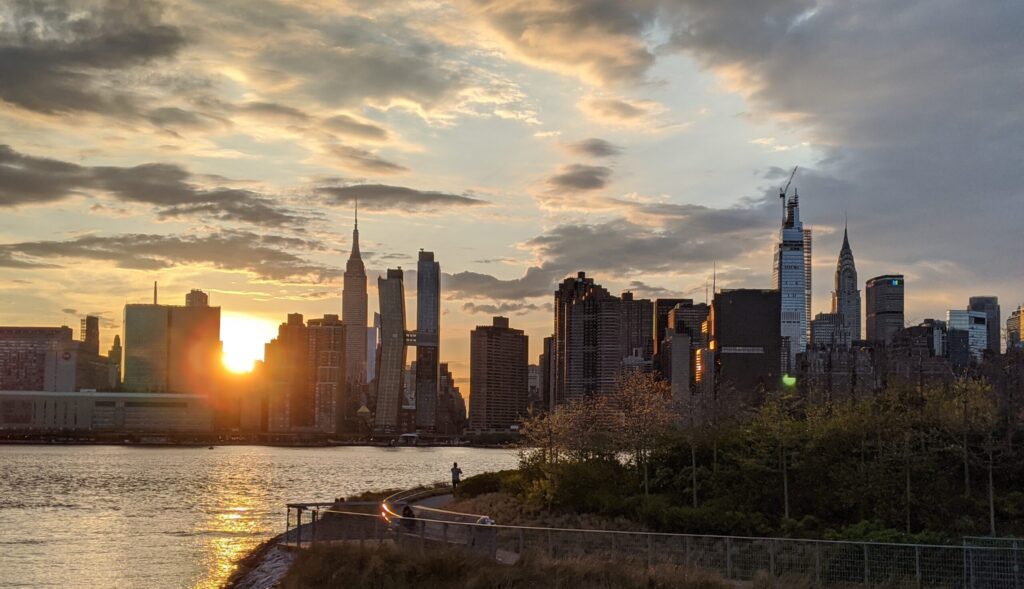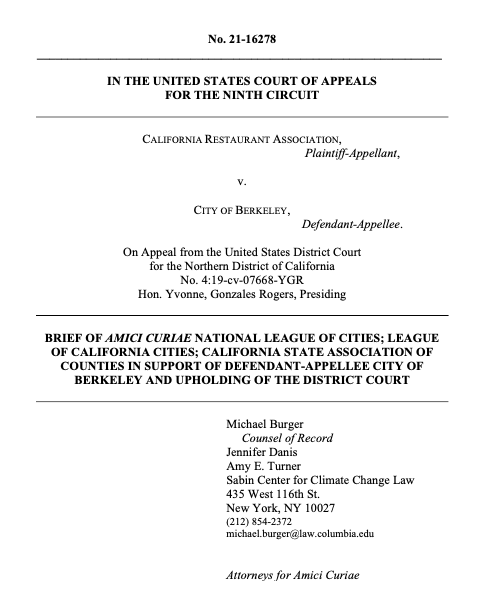Last week, building electrification secured an important victory in the United States District Court for the Southern District of New York. In Association of Contracting Plumbers of The City of New York, Inc. et al v. City of New York, plumbing and building trade groups challenged New York City’s Local Law 154 of 2021, a piece of legislation that prohibits fossil fuel combustion in most new buildings. Similar to other challenges against local ‘natural gas bans,’ the plaintiffs in this 2023 lawsuit argued that the federal Energy Policy and Conservation Act (EPCA) preempted Local Law 154. EPCA sets federal energy-efficiency standards for certain appliances, such as refrigerators, furnaces, ranges, and ovens. The Act includes a provision that preempts state and local governments from setting standards “concerning the energy efficiency, energy use, or water use of” products regulated by EPCA. On March 18, 2025, Judge Ronnie Abrams dismissed the lawsuit with prejudice, penning an opinion that upholds Local Law 154 as a valid exercise of local authority beyond the purview of EPCA’s preemption clause.
This blog post discusses Local Law 154, unpacks Judge Abrams’ decision, and ends with a refresher on California Restaurant Association v. City of Berkeley (Berkeley). In Berkeley, a panel for the U.S. Court of Appeals, Ninth Circuit, held that EPCA preempted a Berkeley ordinance that prohibited natural gas piping in new buildings.
Judge Abrams’ Decision in Association of Contracting Plumbers of The City of New York, Inc. et al v. City of New York
Judge Abrams’ decision granting New York City’s Motion to Dismiss in this case zeroes in on the definitional limits of EPCA’s preemption clause to conclude that the plaintiffs’ reasoning cannot reach Local Law 154. The difference between Local Law 154 and Berkeley’s ordinance also plays a key role in Judge Abrams’ opinion. New York City’s Local Law 154 diverges from the ordinance that was at issue in the Berkeley case. Instead of a wholesale prohibition on natural gas piping, Local Law 154 sets indoor air emissions limits for fossil fuel combustion in new building construction, prohibiting the burning of “any substance that emits 25 kilograms or more of carbon dioxide per million British thermal units of energy.” This indirectly prohibits the installation of natural gas appliances, compelling developers to install appliances like induction burners and heat pumps. In general, the limits went into effect in 2024 for buildings under seven stories; for buildings over seven stories, the limits begin in 2027.
Mimicking Berkeley, the plaintiffs in the New York City case argued that Local Law 154 is expressly preempted by EPCA because the law “‘concerns’ the ‘energy use’ of covered products, in that it ‘ban[s] an appliance from using any energy[,] . . . thus setting its maximum energy use to zero.” To determine whether EPCA preempts Local Law 154, the Court considered (1) the meaning of “energy use,” and (2) whether Local Law 154 “concern[s]” energy use within the meaning of EPCA.
As to the first issue, the Court concluded that “energy use” means a “fixed value, determined using administratively prescribed procedures . . . that represents the amount of energy a product consumes under typical conditions.” In so finding, the Court declined to adopt the definition employed by the Ninth Circuit in Berkeley, which the Court noted, “focused on a flawed reading of the term ‘point of use.’” Instead, Judge Abrams agreed with the Ninth Circuit dissent’s interpretation of “energy use” as a performance standard and that the term “point of use” does not create an absolute consumer right to use covered products.
Recognizing “energy use” as a fixed value, the Court briefly discussed the definition of “related to” and “concerning.” Judge Abrams reasoned that these terms must be understood in the context of EPCA’s structure and intent—focusing on appliance performance rather than fuel choices—and determined that Local Law 154 does not “concern” the subject matter of EPCA. EPCA sets energy conservation standards for covered products, and it requires that those products be tested for compliance with such standards and labeled accordingly. The Court viewed this structure as evidence that Congress intended to preempt state regulations that “bear on the performance of a [covered] product as manufactured.” In other words, EPCA’s text and structure clearly intended to avoid “a patchwork of conflicting and unpredictable” regulations. Local Law 154, however, is not connected to EPCA because it does not “focus[] on” the performance standards applicable to products. Instead, it indirectly regulates “the type of fuel that a covered product may consume in certain settings, irrespective of that product’s energy efficiency or use.” In this way, the law does not cause a covered appliance’s energy use to go to zero, as the panel in Berkeley determined. It just limits the types of fuel a covered product may consume in new buildings.
Local Law 154’s regulation of certain types of fuels in buildings is not an unusual overreach of municipal government either, Judge Abrams noted, but an integral part of state and municipal authority. Additionally, while manufacturers of covered products may see a decrease in demand for such products, they are still subject to the same national standards, further supporting the view that Local Law 154 is “not the kind of burdensome state . . . regulation Congress sought to preempt” and does “not impose performance standards by proxy.”
This decision is the first to openly disagree with the Ninth Circuit’s ruling in Berkeley, a decision that produced a notable chilling effect on similar local laws being considered across the country. Now, with improved legal support, local governments may be more empowered to reconsider those building decarbonization ordinances.
California Restaurant Association v. City of Berkeley
In 2019, the City of Berkeley, California passed a law banning the installation of gas infrastructure in newly constructed buildings. This ‘natural gas ban’ was the first local ordinance in the country to effectively require all-electric construction of new buildings. A trade group first challenged the law in the U.S. District Court for the Northern District of California, which ruled that EPCA did not preempt Berkley’s ordinance.
In reversing the District Court’s Decision on April 17, 2023, the Ninth Circuit held that EPCA preempts state and local standards that interfere with “the end-user’s ability to use installed covered products at their intended final destinations” (emphasis in original). In other words, the Ninth Circuit ruled that Berkeley’s ordinance was preempted because it “concern[ed] . . . energy use” by reducing “energy use” to zero for the appliances effectively prohibited by the ban. As noted in our blog post on the decision, this ruling contrasted with the District Court, which concluded that EPCA preemption should be interpreted as limited in order to avoid “sweep[ing] into areas that are historically the province of state and local regulation.”
Berkeley’s holding is binding authority in courts located within the Ninth Circuit, but in states within different circuits, the ruling is only persuasive authority. Local Law 154 passed before the Berkeley decision, and because New York sits within the Second Circuit, Berkeley’s holding did not automatically apply. The plaintiffs challenging Local Law 154 used the same arguments that were successful in the Ninth Circuit to assert that the law is federally preempted. As discussed above, those arguments were dismissed at the District Court level.
Conclusion
With this legal win, New York City can continue implementing Local Law 154, which, along with other laws like Local Law 97, puts the City in a better position to reach its climate goals and improve its air quality. More broadly, this decision demonstrates that building decarbonization laws that focus on performance standards rather than outright bans are on strong legal footing, especially when considered alongside other successful local performance-based building decarbonization laws. Local governments aiming to lower their emissions from buildings– who might have been reluctant to take on the subject matter due to Berkeley’s outcome – may look to Local Law 154 as a legally defensible approach to building decarbonization. The plaintiffs have stated that they will appeal to the U.S. Court of Appeals, Second Circuit. Importantly, Judge Abrams’ concluding opposite to that of the Ninth Circuit panel in Berkeley sets up a potential circuit split on EPCA interpretation.
Vincent M. Nolette is the Sabin Center's Equitable Cities Climate Law Fellow.



